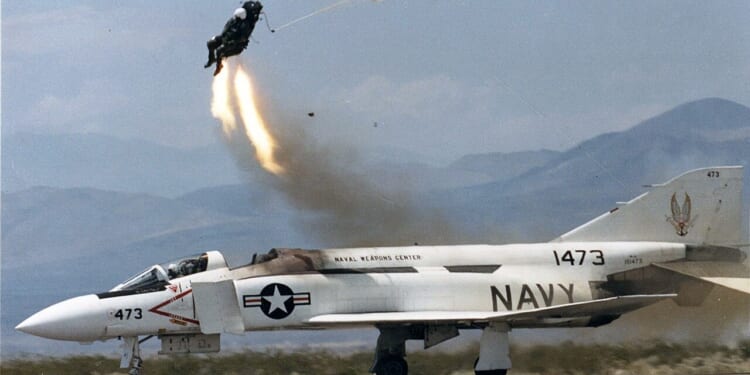Ejector seats are designed to be as safe as possible—but there are obvious inherent dangers in a rocket-powered ejection from a fast-moving aircraft.
Ejecting from a fighter jet is a wrenchingly violent experience—yet paradoxically, it has routinely saved lives. Designed as a last-resort escape system for an aircraft expected to crash, the ejection seat makes what would be a lethal accident into a survivable one. Still, it does so with physics that are plainly extremely dangerous for the human body. When pilots initiate the ejection sequence, they go from sitting strapped in a cockpit to being blasted hundreds of feet into the air by rockets—all in a few tenths of a second. So while survival has become more likely than not for ejecting pilots, danger is inherent, with a high risk of significant injury—and some measure of discomfort guaranteed.
How Aircraft Ejector Seats Work
Modern fighter jets rely on ejection seats as an absolute last resort in the chain of safety. When every single other option fails, the ejection seat gives the pilot one last chance to survive.
The ejection sequence begins the moment the handle is pulled. In quick succession, the plane’s canopy is either blown off or shattered, and the seat’s rocket motor ignites, propelling the pilot upward at tremendous speed. In an instant, stabilizing drogue chutes deploy, the seat separates from the pilot, and a main parachute opens.
Each of these steps happens automatically in a carefully timed sequence, choreographed to preserve life. But the sequence imposes its own risks upon the pilot.
All the Ways an Ejection Can Kill You
Extreme acceleration (g-loads), resulting from the seat’s rocket launch, can subject the occupant to try high upward acceleration (briefly in the double-digit g range.) Such a high g-load compresses the spine and can cause vertebral fractures, spinal cord injury, or other forms of trauma.
Relatedly, the occupant is forced violently into restraints; head, neck, and check injuries, including broken ribs, are common. The force of the ejection can also cause limbs to flail. If arms or legs are not tucked, they can strike the cockpit structure, the canopy, or the airframe during ejection, resulting in fractures, amputations, or severe lacerations. Training emphasizes posture to prevent such limb flailing during ejection.
The pilot must also clear the cockpit and canopy and airframe cleanly, as impact with any of these structures can be catastrophic. In the famous 1986 film Top Gun, Maverick’s crewmate and best friend, Goose, is killed after his head strikes the plane’s canopy during an ejection—a realistic scenario that was based on an actual incident.
The timing of the parachute deployment (which the pilot does not control) is vital. If the parachute opens too quickly, it can cause injury to the spine or limbs. Also, parachute entanglement with the seat itself can prevent proper deployment, likely resulting in death.
Even if the ejection goes well mechanically, the pilot is then exposed to environmental risks; at high altitude, hypoxia is a threat. Frostbite, too, as a result of rapid exposure to frigid temperatures.
And of course, once on the ground, after a fully “successful” ejection, the pilot must survive the landing, evade threats (if over enemy territory), or survive in harsh environments until being rescued.
In essence, ejection is the least bad option in the worst possible scenario for a pilot. It is better than remaining in the crashing aircraft, which would result in almost certain death. Despite being a life-saving procedure credited with saving thousands of lives, the injuries can be significant—spinal fractures, broken bones, and soft-tissue trauma. Still, a high chance of short-term injury is worthwhile for a chance at survival in an otherwise fatal situation.
About the Author: Harrison Kass
Harrison Kass is a senior defense and national security writer at The National Interest. Kass is an attorney and former political candidate who joined the US Air Force as a pilot trainee before being medically discharged. He focuses on military strategy, aerospace, and global security affairs. He holds a JD from the University of Oregon and a master’s in Global Journalism and International Relations from NYU.
Image: Shutterstock.


















